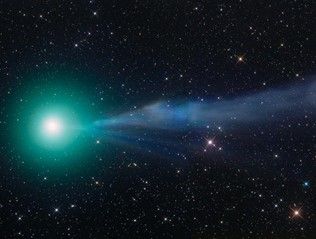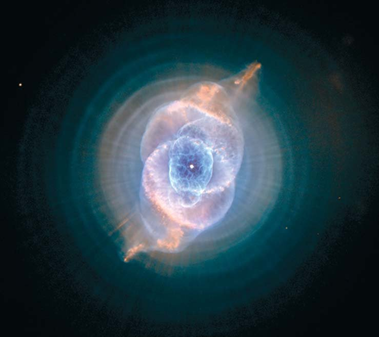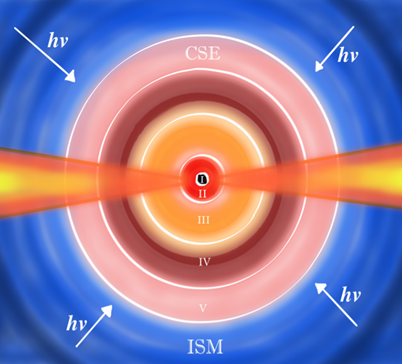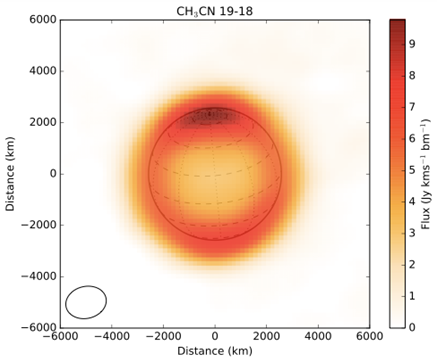Theory & Observation Group
Theory & Observation Group
Our research group is part of the Astrochemistry Laboratory in the Solar System Exploration Division at NASA's Goddard Space Flight Center. We specialize in developing theoretical models for the formation and destruction of molecules in comets, the interstellar medium, circumstellar envelopes, and other extraterrestrial environments. In combination with spectroscopic observations using radio/submillimeter/infrared telescopes, we investigate the chemical origins and evolution of matter throughout the Galaxy.

Matter in the Galaxy passes through a cycle, each phase with its own unique chemical characteristics. We start with nonequilibrium gas and solid-phase chemistry in an interstellar cloud, which collapses under gravity to form a young star with a protoplanetary disk, which persists for millions of years, spanning a wide range of temperatures and densities. Planets and other, smaller icy/rocky bodies form out of the gas and dust in the disk, some of which are preserved as comets, far from the star. Meanwhile, planetary matter undergoes dramatic alteration through geological and atmospheric photochemical processing. At the end of its life, the star runs out of fuel and undergoes mass loss, returning chemically-enriched gas and dust back to the interstellar medium, and the cycle continues.
In the NASA Goddard Astrochemistry Laboratory Theory and Observations Group, we study the chemical evolution of matter as it passes through the above phases. We focus in particular on the origin of complex organic molecules, and the use of isotopes to reveal the cosmic history of Solar System materials.
Observational and Theoretical Studies of Comets

Optical Image of comet C/2014 Q2 (Lovejoy). Credit: Gerald Rhemann

Chemical-hydrodynamic coma model results from Cordiner & Charnley (2021) demonstrating the gas-phase synthesis of several commonly-observed molecules in the coma.
Comets are the icy remnants of planet formation, and contain some of the oldest, most pristine matter from the birth of our Solar System. Studying comets provides direct information on the chemical conditions that prevailed when our planets formed 4.5 billion years ago. In the NASA Goddard Theory and Observations Group, we focus on observations of comets at radio wavelengths, studies of molecular distributions in the coma, and chemical modeling of cometary outflows.
Chemical Models for Interstellar Clouds

Infrared image of the Eagle Nebula obtained using JWST. Stars are born inside the dense, blue-gray "pillars of creation" - vast clouds of dense interstellar gas and dust.

Fractional abundances as a function density in a chemical kinetic model for dense interstellar cloud environments (Dufour & Charnley 2019).
Chemical models for interstellar clouds are crucial for understanding the complex reactions that occur in the cold, dense regions of space where stars and planets form. A multitude of methods, both stochastic and deterministic, are employed to simulate the intricate interplay between gas-phase reactions and surface processes on interstellar dust grains. Key elements, such as hydrogen, carbon, nitrogen, and oxygen, undergo a series of reactions, leading to the creation of molecules like CO, H2O, and various organic compounds. The formation of these molecules can be influenced by autocatalytic processes, which enhance specific reaction pathways and contribute to the overall complexity of interstellar chemistry. Non-linear phenomena, including bistability and oscillations, occur as a result of the complex astrochemical kinetics. Furthermore, the physical parameter such as temperature, density, cosmic ray ionization rates, and ultraviolet radiation, all affect these reaction pathways.
Evolved Star Chemistry

Hubble Space Telescope image of the Cat's Eye Nebula, an evolved (AGB) star undergoing a series of mass-ejection events, creating cool shells of expanding molecular gas and dust (ESA, NASA, HEIC and the Hubble Heritage Team, STScI/AURA).

Schematic structure of an AGB star, divided into 6 regions: (I) a degenerate C/O core and He/H burning shell, (II) a convective shell, (III) a stellar atmosphere where parent molecules are formed, (IV) a dust formation shell with an expanding envelope, (V) a cool, outer envelope where new molecules are formed.
An asymptotic giant branch (AGB) star is a low or intermediate mass star (< 8M⊙) at a late evolutIonary phase in its life. The star evolves into a degenerate C/O core, undergoes intense mass loss and injects dust and molecules into the surrounding regions, creating a circumstellar envelope (CSE). The molecular content, and also the grain types, in the CSEs of AGB stars are to a large extent determined by the C/O raIo of the central star. Depending on this ratio, AGB stars are divided into three different spectral types: C-rich AGB stars (C/O>1), O-rich or M-type AGB stars (C/O<1) and Stype AGB stars (C/O≈1).
Planetary Atmospheres

Emission from CH3CN in the atmosphere of Titan, observed using ALMA (May 2017). Spatial resolution (beam size) is shown lower left. Insights into atmospheric chemistry and seasonal dynamics are inferred from the molecular distribution (see Cordiner et al. 2019 for details).

CH3CN Doppler wind map derived from ALMA observations of Titan, showing East-West flow, corresponding to fast stratospheric zonal winds. Contour labels are in units of m/s. Surprising temporal variability of Titan's high-altitude winds was recently detected by our group.
Titan (Saturn's largest moon) is noteworthy in our Solar System due to its unusually thick, dense (1.45 bar) atmosphere composed predominantly of molecular nitrogen and methane, subject to a complex atmospheric chemistry driven by solar radiation, cosmic rays, and charged particles from Saturn's magnetosphere. Studies of Titan therefore provide unique insights into atmospheric processes such as photochemistry, winds and global circulation in a unique physical and chemical environment, more analogous to Earth than the other terrestrial planets.
